
Nuclear warfare, also known as atomic warfare, is a theoretical military conflict or prepared political strategy that deploys nuclear weaponry. Nuclear weapons are weapons of mass destruction; in contrast to conventional warfare, nuclear warfare can produce destruction in a much shorter time and can have a long-lasting radiological result. A major nuclear exchange would likely have long-term effects, primarily from the fallout released, and could also lead to a "nuclear winter" that could last for decades, centuries, or even millennia after the initial attack. Some analysts dismiss the nuclear winter hypothesis, and calculate that even with nuclear weapon stockpiles at Cold War highs, although there would be billions of casualties, billions more people living in rural areas would nevertheless survive. However, others have argued that secondary effects of a nuclear holocaust, such as nuclear famine and societal collapse, would cause almost every human on Earth to starve to death.

On the Beach is a post-apocalyptic novel published in 1957, written by British author Nevil Shute after he emigrated to Australia. The novel details the experiences of a mixed group of people in Melbourne as they await the arrival of deadly radiation spreading towards them from the Northern Hemisphere, following a nuclear war the previous year. As the radiation approaches, each person deals with impending death differently.

Nuclear weapons possess enormous destructive power from nuclear fission or combined fission and fusion reactions. Building on scientific breakthroughs made during the 1930s, the United States, the United Kingdom, Canada, and free France collaborated during World War II, in what was called the Manhattan Project, to build a fission weapon, also known as an atomic bomb. In August 1945, the atomic bombings of Hiroshima and Nagasaki were conducted by the United States against Japan at the close of that war, standing to date as the only use of nuclear weapons in hostilities. The Soviet Union started development shortly after with their own atomic bomb project, and not long after, both countries were developing even more powerful fusion weapons known as hydrogen bombs. Britain and France built their own systems in the 1950s, and the list of states with nuclear weapons has gradually grown larger in the decades since.

Nuclear weapons tests are experiments carried out to determine nuclear weapons' effectiveness, yield, and explosive capability. Testing nuclear weapons offers practical information about how the weapons function, how detonations are affected by different conditions, and how personnel, structures, and equipment are affected when subjected to nuclear explosions. However, nuclear testing has often been used as an indicator of scientific and military strength. Many tests have been overtly political in their intention; most nuclear weapons states publicly declared their nuclear status through a nuclear test.
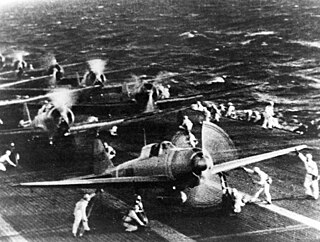
The Pacific War, sometimes called the Asia–Pacific War, was the theater of World War II that was fought in Asia, the Pacific Ocean, the Indian Ocean, and Oceania. It was geographically the largest theater of the war, including the vast Pacific Ocean theater, the South West Pacific theater, the Second Sino-Japanese War, and the Soviet–Japanese War.
USS Seadragon (SSN-584), a Skate-class submarine, was the second ship of the United States Navy to be named for the seadragon, a small fish commonly called the dragonet. This ship was a nuclear-powered submarine.
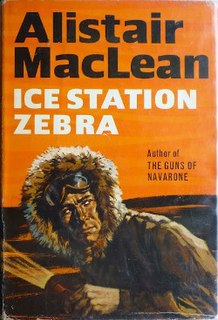
Ice Station Zebra is a 1963 thriller novel written by Scottish author Alistair MacLean. It marked a return to MacLean's classic Arctic setting. After completing this novel, whose plot line parallels real-life events during the Cold War, MacLean retired from writing for three years. In 1968 it was loosely adapted into a film of the same name.

The Bedford Incident is a 1965 British-American Cold War film starring Richard Widmark and Sidney Poitier and co-produced by Widmark. The cast also features Eric Portman, James MacArthur, Martin Balsam and Wally Cox, as well as early appearances by Donald Sutherland and Ed Bishop. The screenplay by James Poe is based on the 1963 novel by Mark Rascovich, which borrowed from the plot of Herman Melville's Moby-Dick; at one point in the film, the captain is advised he is "not chasing whales now".

Since their public debut in August 1945, nuclear weapons and their potential effects have been a recurring motif in popular culture, to the extent that the decades of the Cold War are often referred to as the "atomic age".

The United States was the first country to manufacture nuclear weapons and is the only country to have used them in combat, with the bombings of Hiroshima and Nagasaki in World War II. Before and during the Cold War, it conducted 1,054 nuclear tests, and tested many long-range nuclear weapons delivery systems.

Weapons of Choice is the first novel of the Axis of Time alternative history trilogy, written by Australian author John Birmingham.
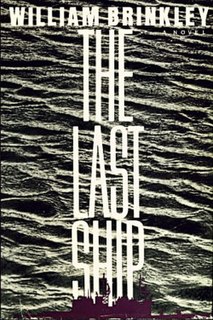
The Last Ship is a 1988 post-apocalyptic fiction novel written by William Brinkley. The Last Ship tells the story of a United States Navy guided missile destroyer, the fictional USS Nathan James (DDG-80), on patrol in the Barents Sea during a brief, full-scale nuclear war between the United States and the Soviet Union. It details the ship's ensuing search for a new home for her crew.

Warday is a novel by Whitley Strieber and James Kunetka, first published in 1984. It is a fictional account of the authors travelling across the U.S. five years after a limited nuclear attack in order to assess how the nation has changed after the war. The novel takes the form of a first-person narrative research article and includes government documents, interviews with survivors and aid workers, and present-tense narration.
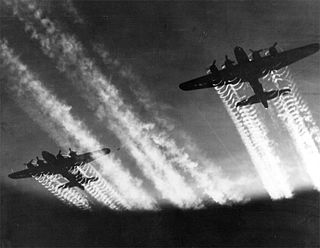
The military history of the United States in World War II covers the victorious Allied war against the Axis Powers, starting with the 7 December 1941 attack on Pearl Harbor. During the first two years of World War II, the United States had maintained formal neutrality as made official in the Quarantine Speech delivered by US President Franklin D. Roosevelt in 1937, while supplying Britain, the Soviet Union, and China with war materiel through the Lend-Lease Act which was signed into law on 11 March 1941, as well as deploying the US military to replace the British forces stationed in Iceland. Following the "Greer incident" Roosevelt publicly confirmed the "shoot on sight" order on 11 September 1941, effectively declaring naval war on Germany and Italy in the Battle of the Atlantic. In the Pacific Theater, there was unofficial early US combat activity such as the Flying Tigers.
World War III, sometimes abbreviated to WWIII, is a common theme in popular culture. Since the 1940s, countless books, films, and television programmes have used the theme of nuclear weapons and a third global war. The presence of the Soviet Union as an international rival armed with nuclear weapons created a persistent fear in the United States and vice versa. There was a pervasive dread of a nuclear World War III, and popular culture reveals the fears of the public at the time.

Pacific Vortex! is an adventure novel by Clive Cussler. Though not the first book to be released featuring the author's primary protagonist, Dirk Pitt, Cussler states that this was the earliest story he wrote starring the popular action hero. Begun in 1965, it was published in 1983 after much internal debate and a great deal of prompting from his friends, family, and publisher. Cussler states in the foreword that he feels the novel is not up to his usual standards and should be treated as a sort of historical curiosity.
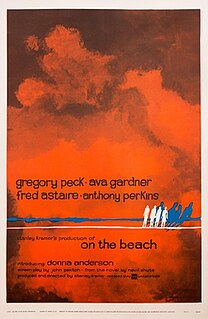
On the Beach is a 1959 American post-apocalyptic science fiction drama film from United Artists, produced and directed by Stanley Kramer, that stars Gregory Peck, Ava Gardner, Fred Astaire, and Anthony Perkins. This black-and-white film is based on Nevil Shute's 1957 novel of the same name depicting the aftermath of a nuclear war. Unlike in the novel, no one is assigned blame for starting the war; the film hints that global annihilation may have arisen from an accident or misjudgment.
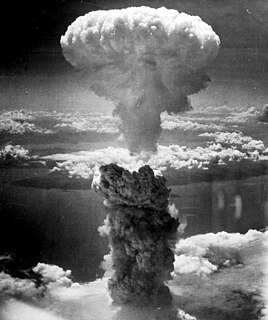
Substantial debate exists over the ethical, legal, and military aspects of the atomic bombings of Hiroshima and Nagasaki on 6 August and 9 August 1945 at the close of World War II (1939–45).

The Pacific Fleet is the Russian Navy fleet in the Pacific Ocean.















